
This article was originally published by a www.houzz.com . Read the Original article here. .

This article was originally published by a www.houzz.com . Read the Original article here. .
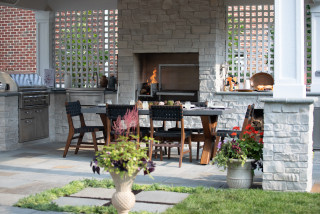
Portable fire pits can be easily added to most outdoor spaces, coming in many sizes and costing less than a permanent installation. “They’re relatively inexpensive, easy to relocate, require minimal cleanup and have little or no smoke to deal with,” Langhorne says.
This article was originally published by a www.houzz.com . Read the Original article here. .

A roof or overhead structure also has some drawbacks. An overhead structure is not recommended above many grills, for safety reasons. If you do have one, be sure you have the appropriate ventilation around the grill and an overhead vent installed. A patio roof can also close off the space unnecessarily.
A fully covered space is both more expensive and permanent, but it will ensure that both your kitchen and those using it are out of the elements. It will easily allow you to add in overhead lighting, heating and fans.
A partial roof can give you some shelter while still allowing you to keep the grill and other cooking areas safely ventilated and away from flammable materials.
This article was originally published by a www.houzz.com . Read the Original article here. .
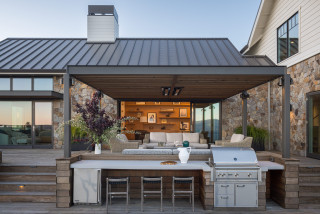
Counters help define your outdoor kitchen’s style. “Choose a stone [or other material] that ties the whole look together or provides a fun accent,” says Kara Gorski of Landed in Alexandria, Virginia.
Practical considerations. Add plenty of countertop area around the grill. “No matter how small an outdoor kitchen is, it needs to have adequate counter space,” says landscape designer Deborah Gliksman of Urban Oasis Landscape Design in Los Angeles. Douglass recommends leaving enough room for utensils as well as your cooked and uncooked food.
New York-based landscape designer Todd Haiman says you’ll probably need to seal the countertop when it’s installed and then reseal it every few years. “Fats from cooking as well as staining from metals left on top of it can stain it, and the elements can take their toll,” he says.
Finally, make good use of the cabinetry the counters sit on. It’s a prime space for storage as well as other amenities, such as an undercounter refrigerator.
Find a landscape contractor near you on Houzz
This article was originally published by a www.houzz.com . Read the Original article here. .

The landscape design includes smart features. “We used a Sonance sound system with two subwoofers and six speakers within the garden spaces, as well as speakers in the cabana that are controlled by a home automation system,” Stucchi says. “The landscape lights, the bistro lights and the lights in the cabana are all controlled by a Lutron system app on the homeowners’ phones.”
Paperbark maples (Acer griseum, USDA zones 4 to 8; find your zone), which are multistemmed trees with beautiful bark, frame the cabana. “About a million resident wild bunnies severely limited our plant palette with their insatiable appetites for herbaceous perennials. No amount of rabbit deterrent would help us there. We tried everything,” Stucchi says.
He used trees, flowering shrubs, evergreens and grasses for structure, color and texture. These include a mix of hydrangeas, ‘Karl Foerster’ feather reed grass (Calamagrostis x acutiflora ‘Karl Foerster’, zones 4 to 9) and both Blushing Knock Out roses (Rosa ‘Radyod’, zones 5 to 11) and Knock Out roses (Rosa ‘Radrazz’, zones 5 to 11).
This article was originally published by a www.houzz.com . Read the Original article here. .
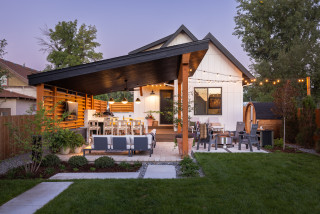
Yard at a Glance
Who lives here: A couple of empty nesters with two dogs
Location: Timnath, Colorado (near Fort Collins)
Size: 3,200 square feet (297 square meters); about 45 feet wide and 60 to 80 feet long
Landscape designer and builder: Lindgren Landscape, with Jamie McCarn as designer
The homeowners wanted a pergola or a covered structure for outdoor entertaining, but that was the extent of their vision. “We talked about enclosing it,” landscape designer Jamie McCarn says of the structure, “but we decided it was too small and we needed to keep everything open.”
They also opted for a substantial roof cover. With a pergola, “you can’t go out in the rain, and you don’t get that solid shade or interior feel. And I know that’s what [the homeowners] were going for,” McCarn says. She angled the roof to open up the look in the tight yard without losing any shelter or protection.
Stained Douglas fir wood beams and posts pop against the black-painted Douglas fir roof, anchoring the structure in the yard and complementing the home’s colors and details. “We never want the landscape to feel scabbed-on. It needs to feel cohesive with the house,” McCarn says.
Find a local landscape designer
This article was originally published by a www.houzz.com . Read the Original article here. .
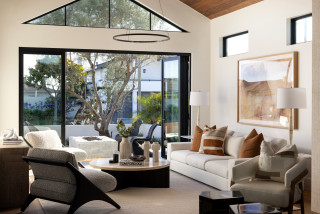
The style of existing windows and doors will have an impact on how easy it is to open up the space, Reader says. “Early uPVC versions often had a large amount of plastic frame, which reduces the area of glass and obstructs the view.”
Having said that, all the same tricks for connecting the spaces still stand, it’s just more difficult to create a direct visual link. “Create focal points that draw attention by using the same materials or styles inside and out,” Reader says. “That way, your eye will be drawn to the elements of the [landscape] that best link the two spaces.”
“Carefully consider the layout of the [yard] and the planting,” Fletcher says. “Maybe pick out an interesting tree or sculpture and make the most of it with lighting.”
“Painting the wall around the window white is another good way to minimize any distraction from the view,” Jones says.
This article was originally published by a www.houzz.com . Read the Original article here. .
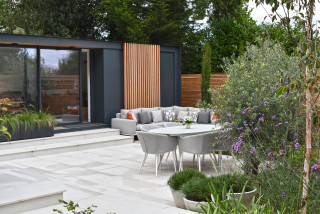
A family in suburban Chicago with Brazilian roots hired Hursthouse Landscape Architects and Contractors, a firm they found on Houzz, to bring South American flavor to their underutilized backyard. A gaucho, or Argentine-style, grill was a top priority, and the firm designed an expansive cooking and dining pavilion around the wood-fired, crank-operated grill. The covered area also includes a gas grill, cabinets, a sink, firewood storage, a trash receptacle and a dining area. The counters are honed bluestone, and the base is Wisconsin limestone. The 500-square-foot natural cleft bluestone patio offers plenty of room for outdoor entertaining, with a fire pit lounge providing another gathering destination. The team was thoughtful in designing the space to nod to the home’s traditional architecture.
Read more about this backyard
10 Outdoor Kitchen Design Features Pros Always Recommend
This article was originally published by a www.houzz.com . Read the Original article here. .

A family in suburban Chicago with Brazilian roots hired Hursthouse Landscape Architects and Contractors, a firm they found on Houzz, to bring South American flavor to their underutilized backyard. A gaucho, or Argentine-style, grill was a top priority, and the firm designed an expansive cooking and dining pavilion around the wood-fired, crank-operated grill. The covered area also includes a gas grill, cabinets, a sink, firewood storage, a trash receptacle and a dining area. The counters are honed bluestone, and the base is Wisconsin limestone. The 500-square-foot natural cleft bluestone patio offers plenty of room for outdoor entertaining, with a fire pit lounge providing another gathering destination. The team was thoughtful in designing the space to nod to the home’s traditional architecture.
Read more about this backyard
10 Outdoor Kitchen Design Features Pros Always Recommend
This article was originally published by a www.houzz.com . Read the Original article here. .

No one has to shiver for long while hastening into the house after soaking in this backyard hot tub in Los Angeles, thanks to its proximity to a doorway. The homeowner got rid of an unused swimming pool so landscape designer Catherine Bosler of Bosler Earth Design could install the hot tub and deck seen here, plus a covered lounge area and plenty of drought-tolerant plantings interwoven with pathways.
Being that the homeowner is British, Bosler looked to the English countryside for inspiration, infusing the space with softness, texture and color. Climbing jasmine grows on the cable railing panel between the deck and hot tub, adding greenery and an enticing fragrance to the space.
Extra-nice touch: The hot tub has built-in shelving along the side for towels and other necessities.
Read more about this project
This article was originally published by a www.houzz.com . Read the Original article here. .
The initial goal of this Illinois project was to build an outdoor pavilion and kitchen on a newly purchased lot next to the homeowners’ existing lot. But one thing led to another, and a team including Joey Rossa of JMR Landscaping, Nick Shaver of Century Bay Builders and interior designer Laurie Demetrio ended up giving the homeowners a pool, a spa, a two-level guesthouse and a two-car garage as well.
The generously appointed pavilion has ceiling heaters and a fireplace to keep things toasty on cooler days, plus ceiling fans to stir up breezes when it’s warm. Cushy seating surrounds a coffee table, promoting conversation and connection. The outdoor kitchen is party-ready with a grill, smoker, pizza oven, wine cooler and more. There’s also a five-seat bar with plenty of countertop space, and a TV above the fireplace.
Read more about this project